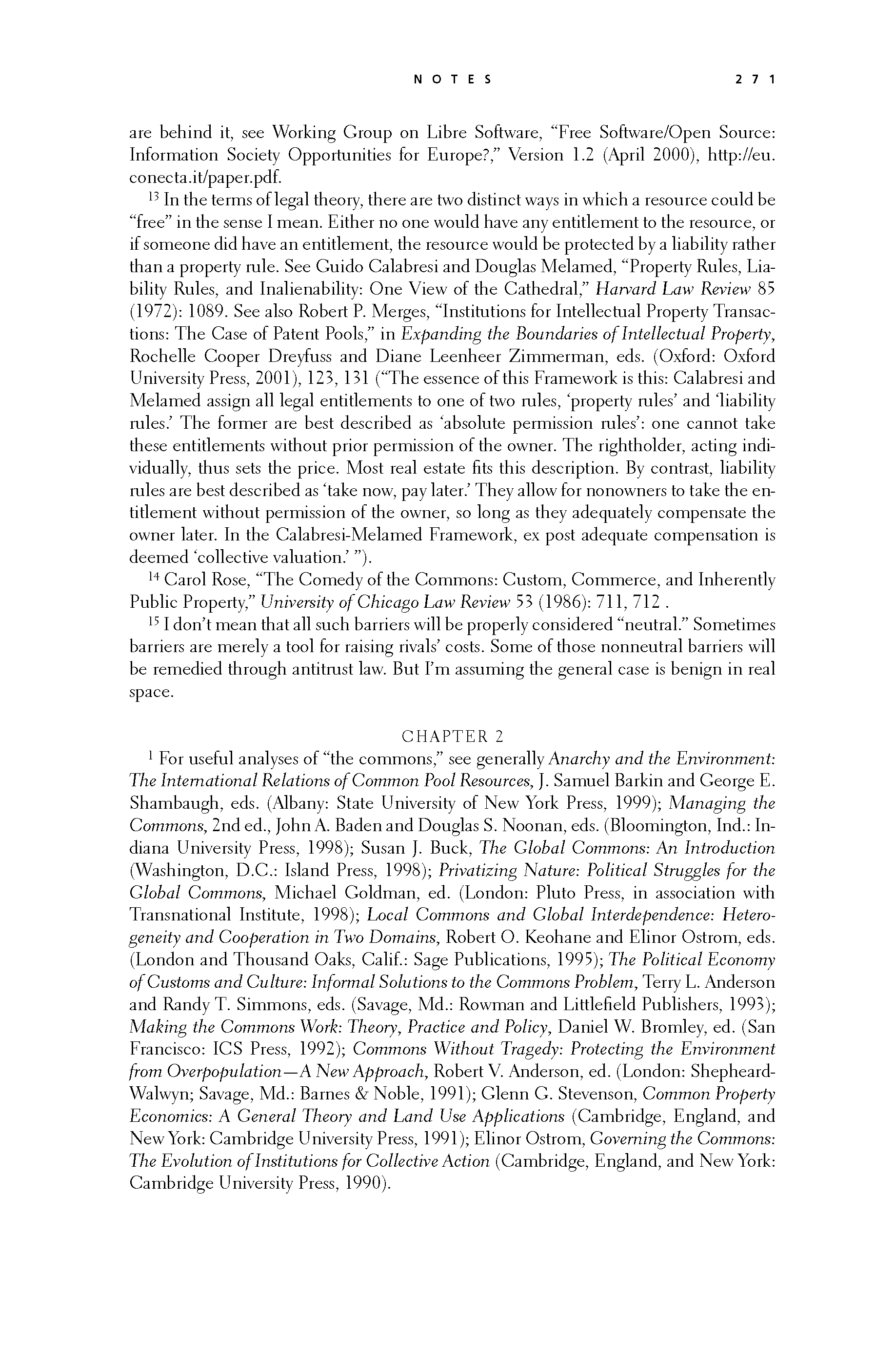 p270 _
-chap- _
toc-1 _
p271w _
toc-2 _
+chap+ _
p272
p270 _
-chap- _
toc-1 _
p271w _
toc-2 _
+chap+ _
p272
are behind it, see Working Group on Libre Software, "Free Software/Open Source:
Information Society Opportunities for Europe?," Version 1.2 (April 2000), http://eu.
conecta.it/paper.pdf.
[1-13] In the terms of legal theory, there are two distinct ways in which a resource could be
"free" in the sense I mean. Either no one would have any entitlement to the resource, or
if someone did have an entitlement, the resource would be protected by a liability rather
than a property rule. See Guido Calabresi and Douglas Melamed, "Property Rules, Lia-
bility Rules, and Inalienability: One View of the Cathedral," _Harvard_Law_Review_ 85
(1972): 1089. See also Robert P. Merges, "Institutions for Intellectual Property Transac-
tions: The Case of Patent Pools," in _Expanding_the_Boundaries_of_Intellectual_Property,_
Rochelle Cooper Dreyfuss and Diane Leenheer Zimmerman, eds. (Oxford: Oxford
University Press, 2001), 123, 131 ("The essence of this Framework is this: Calabresi and
Melamed assign all legal entitlements to one of two rules, 'property rules' and 'liability
rules.' The former are best described as 'absolute permission rules': one cannot take
these entitlements without prior permission of the owner. The rightholder, acting indi-
vidually, thus sets the price. Most real estate fits this description. By contrast, liability
rules are best described as 'take now, pay later.' They allow for nonowners to take the en-
titlement without permission of the owner, so long as they adequately compensate the
owner later. In the Calabresi-Melamed Framework, ex post adequate compensation is
deemed 'collective valuation.'").
[1-14] Carol Rose, "The Comedy of the Commons: Custom, Commerce, and Inherently
Public Property," _University_of_Chicago_Law_Review_ 53 (1986): 711, 712.
[1-15] I don't mean that all such barriers will be properly considered "neutral." Sometimes
barriers are merely a tool for raising rivals' costs. Some of those nonneutral barriers will
be remedied through antitrust law. But I'm assuming the general case is benign in real
space.
Chapter 2
[2-1] For useful analyses of "the commons," see generally _Anarchy_and_the_Environment:_
_The_International_Relations_of_Common_Pool_Resources,_ J. Samuel Barkin and George E.
Shambaugh, eds. (Albany: State University of New York Press, 1999); _Managing_the_
_Commons,_ 2nd ed., John A. Baden and Douglas S. Noonan, eds. (Bloomington, Ind.: In-
diana University Press, 1998); Susan J. Buck, _The_Global_Commons:_An_Introduction_
(Washington, D.C.: Island Press, 1998); _Privatizing_Nature:_Political_Struggles_for_the_
_Global_Commons,_ Michael Goldman, ed. (London: Pluto Press, in association with
Transnational Institute, 1998); _Local_Commons_and_Global_Interdependence:_Hetero-_
_geneity_and_Cooperation_in_Two_Domains,_ Robert O. Keohane and Elinor Ostrom, eds.
(London and Thousand Oaks, CA: Sage Publications, 1995); _The_Political_Economy_
_of_Customs_and_Culture:_Informal_Solutions_to_the_Commons_Problem,_ Terry L. Anderson
and Randy T. Simmons, eds. (Savage, Md.: Rowman and Littlefield Publishers, 1993);
_Making_the_Commons_Work:_Theory,_Practice_and_Policy,_ Daniel W. Bromley, ed. (San
Francisco: ICS Press, 1992); _Commons_Without_Tragedy:_Protecting_the_Environment_
_from_Overpopulation_--_A_New_Approach,_ Robert V. Anderson, ed. (London: Shepheard-
Walwyn; Savage, Md.: Barnes & Noble, 1991); Glenn G. Stevenson, _Common_Property_
_Economics:_A_General_Theory_and_Land_Use_Applications_ (Cambridge, England, and
New York: Cambridge University Press, 1991); Elinor Ostrom, _Governing_the_Commons:_
_The_Evolution_of_Institutions_for_Collective_Action_ (Cambridge, England, and New York:
Cambridge University Press, 1990).
[[271]]
p270 _
-chap- _
toc-1 _
p271w _
toc-2 _
+chap+ _
p272